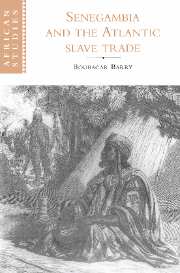Book contents
- Frontmatter
- Contents
- Preface
- Map
- I Senegambia from the fifteenth to the seventeenth century: a haven for incoming populations, a station for migrants on the move
- II Senegambia in the eighteenth century: the slave trade, ceddo regimes and Muslim revolutions
- III Senegambia in the first half of the nineteenth century: legitimate trade and sovereignty disputes
- IV Senegambia in the second half of the nineteenth century: colonial conquest and resistance movements
- Conclusion
- Notes
- Bibliography
- Index
- Other books in the series
I - Senegambia from the fifteenth to the seventeenth century: a haven for incoming populations, a station for migrants on the move
Published online by Cambridge University Press: 31 October 2009
- Frontmatter
- Contents
- Preface
- Map
- I Senegambia from the fifteenth to the seventeenth century: a haven for incoming populations, a station for migrants on the move
- II Senegambia in the eighteenth century: the slave trade, ceddo regimes and Muslim revolutions
- III Senegambia in the first half of the nineteenth century: legitimate trade and sovereignty disputes
- IV Senegambia in the second half of the nineteenth century: colonial conquest and resistance movements
- Conclusion
- Notes
- Bibliography
- Index
- Other books in the series
Summary
Senegambia, bordered by the Senegal River in the north, the Kolonte in the south, and the foothills of the Futa Jallon plateau to the east, has a natural geographical coherence. The region is wide open to the Atlantic ocean and the west. Geographically, its features are remarkably diverse. Still, beneath the surface diversity, the population possesses a profound cultural cohesiveness. On account of this unity, the Senegambian zone has played a special role in West African history since the fifteenth century. For it has been the confluence of all the area's migratory streams, from the watersheds of the Upper Niger valley in the east to the Atlantic ocean in the west; from the Adrar highlands in the north to the Futa Jallon plateau in the south. The resulting mixture blends demographic and cultural traits dating back to the medieval empires of Western Sudan with influences brought in by Berber nomads from the Sahara desert.
A historical cohesiveness parallels this geographical unity. Senegambia was dependent on western Sudan and the Sahara almost until the fifteenth century. Then, with the arrival of the Europeans, old continental influences began yielding to new maritime currents.
- Type
- Chapter
- Information
- Senegambia and the Atlantic Slave Trade , pp. 1 - 4Publisher: Cambridge University PressPrint publication year: 1997



